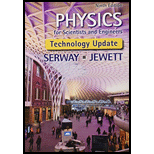
(a)
The image position of the fishes that are located at 5.00 cm 25.0 cm
(a)
Answer to Problem 36.36P
Explanation of Solution
Given info: The radius of curvature of the curved plastic is
The formula to calculate image position of the fish inside the aquarium is,
Here,
The radius of curvature will be negative the centre of curvature lies on the object side.
For part (i): when the fish is at
Substitute
The image position for the fish at
For part (ii) when the fish is at
From equation (2) the image position is,
The image is at
Conclusion:
Therefore, the image is
(b)
The magnification of the images for part (a)
(b)
Answer to Problem 36.36P
Explanation of Solution
Explanation
Given info: The radius of curvature of the curved plastic is
The formula to calculate the magnification of the image is,
For part (i): when the fish is at
Substitute
Thus when the fish is at
For part (ii): when the fish is at
Substitute
Thus when the fish is at
Conclusion:
Therefore, when the fish is at
(c)
The reason refractive index of the plastic is not required to solve the problem.
(c)
Answer to Problem 36.36P
Explanation of Solution
Explanation
The plastic has uniform thickness and the surface from which the ray is entering and the surface from which is leaving are parallel to each other. The ray might get slightly displaced, but it will not change the direction of its propagation by going through plastic air interface. The only difference will be due to water-air interface.
Conclusion:
Therefore, the ray might get slightly displaced, but it will not change the direction of its propagation by going through plastic air interface. So the refractive index of plastic is not playing any major role in light propagation.
(e)
The image distance of the fish is greater than the fish itself and the magnification
(e)
Answer to Problem 36.36P
Explanation of Solution
Explanation
For the object distance greater than the radius of curvature the image distance will greater than the distance at which fish is itself. If the aquarium were very long the radius of curvature will not increase therefore if the object distance is more than the radius of curvature the image of the fish will be at even farther distance away from the fish itself.
Conclusion:
Therefore, If the fish is present at distance larger than the radius of curvature the image of the fish would be even farther than that of fish itself.
(d)
The magnification of the image when the image of the fish is even farther than the position of fish itself.
(d)
Answer to Problem 36.36P
Explanation of Solution
For the condition
Formula to calculate the image distance from Lens formula
Substitute
For the condition
Take reciprocal of the above question
Formula to calculate the image distance from Lens formula,
Divide by
The condition is when the image distance is greater than the radius of curvature take the magnitude of the equation.
Substitute
The reciprocal of the equation is
Thus the image of the fish will also be at greater distance than that of radius of curvature.
An example for the above case is let the fish is at twice the distance of the magnitude of radius of curvature.
The image of the fish is calculated from the formula from equation (7).
Substitute
Thus the image of the fish is
The formula to calculate the magnification of the image is,
Substitute
Thus the magnification of the fish image is
Conclusion:
Therefore, if the fish is present at distance larger than the radius of curvature the image of the fish would be even farther than that of fish itself.
Want to see more full solutions like this?
Chapter 36 Solutions
Bundle: Physics for Scientists and Engineers, Technology Update, 9th Loose-leaf Version + WebAssign Printed Access Card, Multi-Term
- Can someone help me with this question. Thanks.arrow_forwardIdentical rays of light enter three transparent blocks composed of different materials. Light slows down upon entering the blocks.arrow_forwardFor single-slit diffraction, calculate the first three values of (the total phase difference between rays from each edge of the slit) that produce subsidiary maxima by a) using the phasor model, b) setting dr = 0, where I is given by, I = Io (sin (10) ². 2arrow_forward
 Physics for Scientists and EngineersPhysicsISBN:9781337553278Author:Raymond A. Serway, John W. JewettPublisher:Cengage Learning
Physics for Scientists and EngineersPhysicsISBN:9781337553278Author:Raymond A. Serway, John W. JewettPublisher:Cengage Learning Physics for Scientists and Engineers with Modern ...PhysicsISBN:9781337553292Author:Raymond A. Serway, John W. JewettPublisher:Cengage Learning
Physics for Scientists and Engineers with Modern ...PhysicsISBN:9781337553292Author:Raymond A. Serway, John W. JewettPublisher:Cengage Learning Principles of Physics: A Calculus-Based TextPhysicsISBN:9781133104261Author:Raymond A. Serway, John W. JewettPublisher:Cengage Learning
Principles of Physics: A Calculus-Based TextPhysicsISBN:9781133104261Author:Raymond A. Serway, John W. JewettPublisher:Cengage Learning College PhysicsPhysicsISBN:9781305952300Author:Raymond A. Serway, Chris VuillePublisher:Cengage Learning
College PhysicsPhysicsISBN:9781305952300Author:Raymond A. Serway, Chris VuillePublisher:Cengage Learning College PhysicsPhysicsISBN:9781285737027Author:Raymond A. Serway, Chris VuillePublisher:Cengage Learning
College PhysicsPhysicsISBN:9781285737027Author:Raymond A. Serway, Chris VuillePublisher:Cengage Learning University Physics Volume 3PhysicsISBN:9781938168185Author:William Moebs, Jeff SannyPublisher:OpenStax
University Physics Volume 3PhysicsISBN:9781938168185Author:William Moebs, Jeff SannyPublisher:OpenStax





